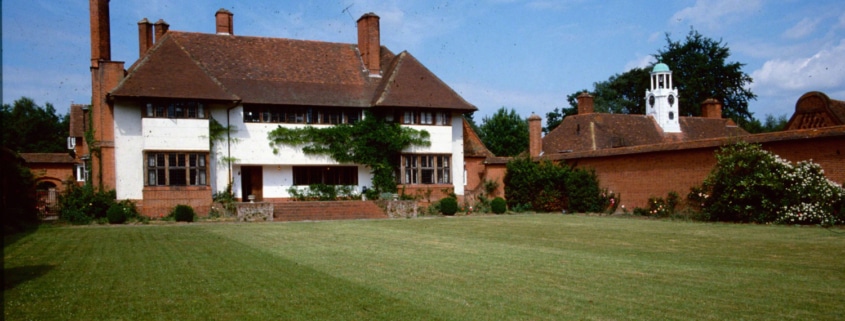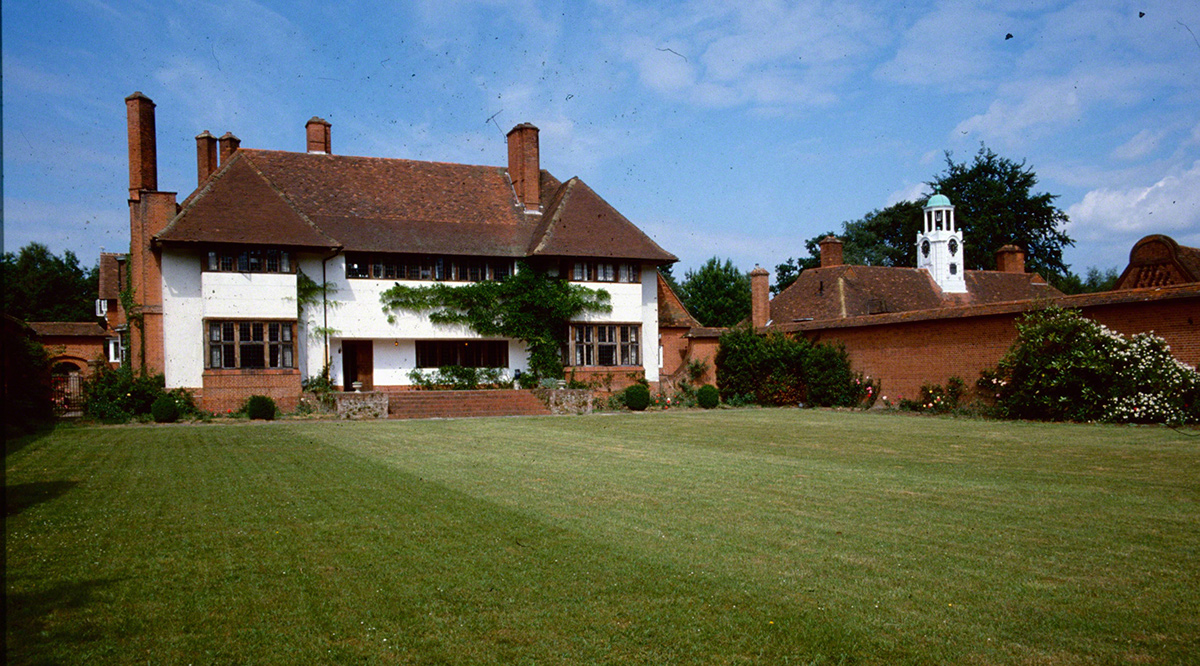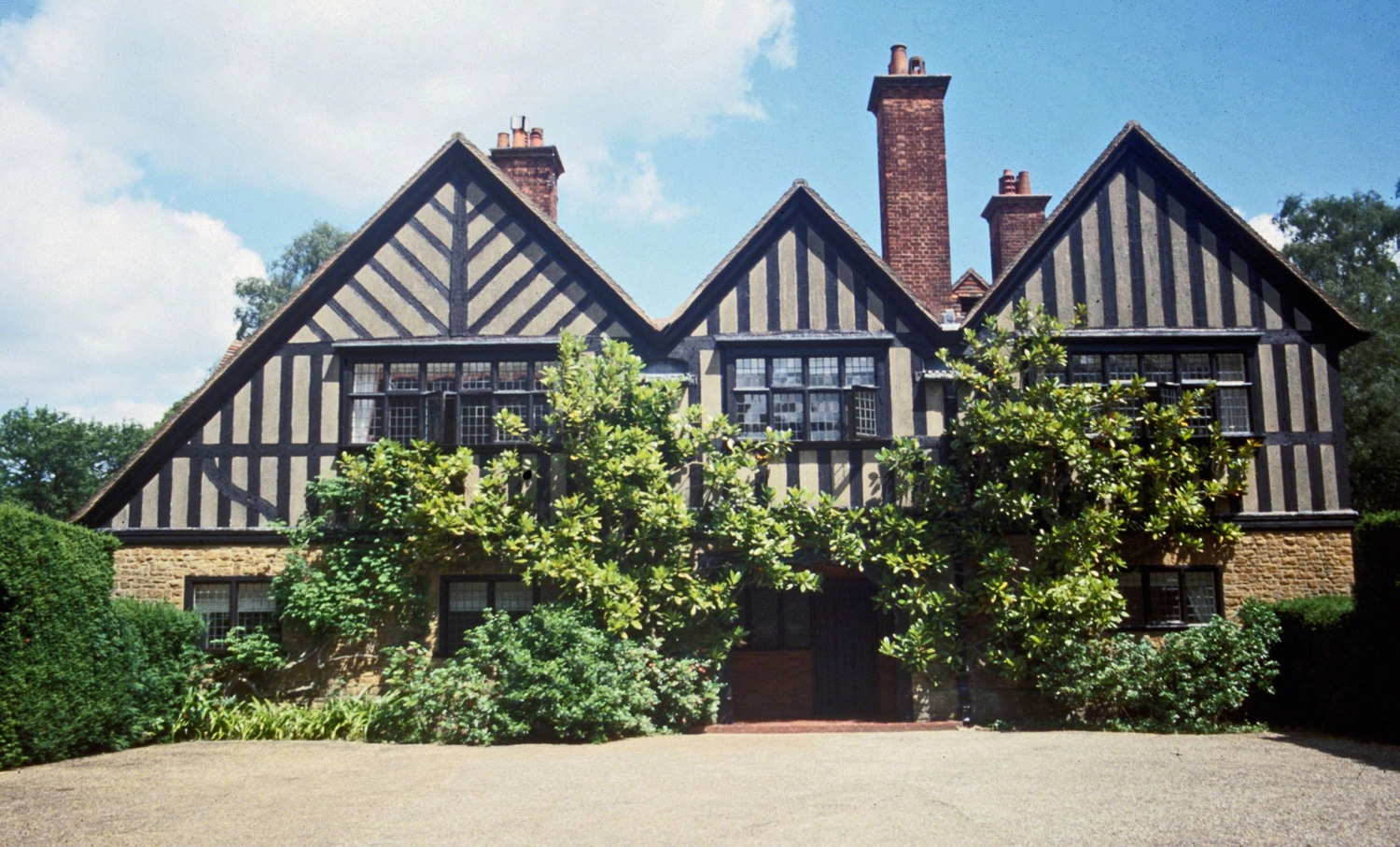
Description
The house is Lutyens’s ‘potted biography’ as it shows the changing nature of his style up to 1914. Although the gardener’s cottage was his first complete work, Crooksbury itself was his first country house. It has an L-shaped plan, is half-timbered in the Shaw style, with tile-hung South side and service wing. Nicholas Taylor notes that the garden side was ‘one of the best things he ever did, informal, with strong horizontals formed by the eaves and by curving out the foot of the tile-hanging, a local trick he was fond of (cf. Fulbrook). The effect here of space flowing uniformly in all directions is a true equivalent to Frank Lloyd Wright’.Then in 1898-99 an East wing was added to create Fig Tree Court. It was Tudor on the West and South, and the East elevation was Lutyens’s first experiment in a Georgian style. This he replaced in 1914 with a symmetrical front of rough cast, with hipped roof, to meet the requirements of the new owner, Chapman having sold the house. This addition is more staccato in its juxtaposition of forms than the vernacular of the original 1889-90 house. The garden was by Gertrude Jekyll, mainly of 1892 and 1902. The client was Arthur Chapman, Chairman of Surrey County Council, a Calcutta merchant. His wife Agnes, who was the daughter of Captain Mangles of Poyle Park, Tongham, had been painted by Lutyens’s father. (Amery et al, 1981, cat no. 45)
By Lutyens, who in later life would not re-visit it, because ‘it had too many memories’. The house is his potted biography in three separate phases. The original building, at the W end, is of 1890–2, a weekend cottage for Mr and Mrs Arthur Chapman. It consists of a close-studded and herringbone brick N entrance front, in style leaning heavily on Ernest George and Norman Shaw, with the porch at the head of steps and tucked into the corner of a gabled cross-wing to the l.; a service wing, tile-hung, extends this into an L. The star-shaped chimney on a heavy breast (inglenook inside) copies the chimney of a cottage of Shere. The garden side (S) is informal, with strong horizontals formed by the eaves of its deep roof, which has two small dormers and extends over a veranda in the centre; to the r. a double-gabled cross-wing, with tile-hanging curved out at the foot. The inside of this part, with intimate space floating from room to passage to staircase, all on different levels, is as experimental and fresh as anything Wright was doing in 1890. Then, in 1898–9, Chapman enlarged his cottage into a country house, with an E wing that is in effect a completely new dwelling. The façade to the E lawn was Lutyens’s first domestic classical exterior, brick, eight bays with segment-headed windows, shallow quoined wings and segmental-pedimented doorcase offset to the l., late C17 style.* On the S side a canted bay below an open balcony with some mildly Art Nouveau ironwork. Joining the new and old parts a narrow two-storey corridor with circular, saucer domes on squinches divided by arches, lit by circular windows. The space between the wings on the S side is a paved garden (Fig Tree Court) with pergola; to the N was a kitchen court (now infilled).
The house changed hands, and in 1914 the new owner, Mr T. E. Briggs, wanted Surrey vernacular – and Lutyens provided it, settling a large hipped roof on his E wing with cross-hips over the wings, tile-hanging and jettying the upper floor, rendering the rest and adding square bays with leaded casements. At the same time he added another chimney to the rear, in the style of Tigbourne, which in the circumstances was a sort of self-abuse. This served an addition to the library, with C17-style plasterwork, Ionic pilasters and an over-scaled bolection-moulded fireplace. It is all a very sad commentary, particularly as the 1898 work was so good and because it makes a nonsense of Lutyens’s own carefully cultivated effect of a house developed over centuries. As Harold Falkner said in a letter to Country Life in 1944, ‘there is not a single detail that could not have been carried out by assistants with details already used’. The 1914 work also included large tile-hung service wings.
N of these are the STABLES, partly of 1890, but mainly of 1901–2, one of Lutyens’s earliest ‘Wrenaissance’ designs, with a lively rusticated cupola and a subtle splaying of the wings. The rear wing has a bowed centre with a characterful doorcase with fretwork consoles and segmental-arched fanlight. Garden by Gertrude Jekyll mainly of 1892 and 1902, with high tile-gabled walls and brick revetted terraces. Down the drive is a GARDENER’S COTTAGE of 1889, Lutyens’s first complete building. L-shaped, roughcast, with a single splendid chimney. (O’Brien et al, 2022, pp.233-4)
Bibliography
Amery, C., Richardson, M. and Stamp, G. (1981) Lutyens, the Work of the English Architect Sir Edwin Lutyens (1869-1944): Hayward Gallery London, 18 November 1981-31 January 1982. London: Arts Council of Great Britain.O’Brien, C., Nairn, I. and Cherry, B. (2022) Surrey. Pevsner Architectural Guides: Buildings of England. New Haven: Yale University Press.
Also Cited In
Gradidge, R. (1982) Edwin Lutyens: Architect Laureate. London: Allen & Unwin.Weaver, L. (1913) Houses and Gardens by E L Lutyens. London: Country Life.
Amery, C., Richardson, M. and Stamp, G., (1981) Lutyens, the Work of the English Architect Sir Edwin Lutyens (1869-1944): Hayward Gallery London, 18 November 1981 – 31 January 1982. London: Arts Council of Great Britain.
Aslet, C. (1982) The Last Country Houses. New Haven: Yale University Press.
Nairn, I., Pevsner, N. (1971) Surrey (Pevsner Architectural Guides: Buildings of England). 2nd edn. Yale University Press.
country HOMES GARDENS OLD&NEW: CROOKSBURY, ..NEAR FARNHAM, SURREY. 1900. Country Life Illustrated (Archive : 1897-1901), 8(193), pp. 336-341.
Listing Grade
II,II,II,II,II,IIListing Reference
1044447 1189091 1294451 1294507 1352740 1352741Client
Arthur W Chapman

